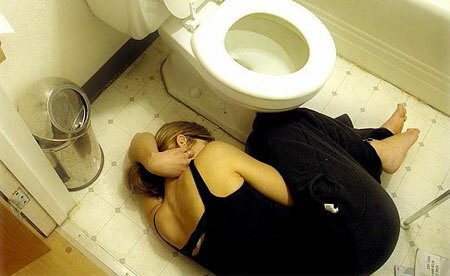The most common name in medicine for a disease caused by uncontrolled overeating is bulimia or movieorexia.
Symptoms of the disease can occur in certain pathologies due to excessive accumulation of adipose tissue( obesity), bulimia nervosa, or endogenous mental illness. But it can also be an independent pathology in perfectly healthy, normal people.
Contents of
- 1 Bulimia - what is it?
- 2 Symptoms of Bulimia by Developmental Forms
- 3 Bulimia Symptoms
- 4 Treatment of Bulimia - Procedures and Drugs
- 4.1 Psychotherapeutic Treatment of Bulimia
- 4.2 Drugs and Remedies for Bulimia
- 4.3 Complications of Filmorexia
Bulimia - What Is It?
Bulimia is the most common form of behavioral disorders in food caused by the manifestation of insatiable( wolfish) hunger. In multiple cases, bulimic pathology can be a consequence of psychogenic disorders in patients with mental and neurological problems, often adjacent to anxiety and phobias, with syndromes of depressive conditions.

The manifestation of the disease is characterized by an alternation( alternation) of two stages:
- An indefatigable hunger sense accompanied by an excellent appetite with an absent mechanism of sense of proportion. As they say in plain language - "no brake".
- The second stage - the maximum disposal of food eaten by any means, even harmful to health.
The duration of each stage can be any, depending on the severity of the abnormal process, manifested by different symptomatic symptoms at the behaviouristic( behavioral) level, or as a result of mental and physiological dependence.
Cognoric disorders: causes of
The genesis of the abnormalities is based on presumptive variants, as it has not been studied for certain. However, predisposing leading factors have been identified which trigger the manifestation of kinorerexia. These include:
- Genetic inheritance of family psychic, somatoform( contrived), depressive and anxious-phobic pathologies;
- Anatomical defects in various functions of the central nervous system;
- Endocrine and metabolic pathologies;
- Failures in the inhibitory function of neurotransmitters of the central nervous system;
- Hereditary chronic dependence of "ancestors" to alcohol or drugs.
Against the backdrop of even one of these disorders, an unconscious life scenario can be formed in the unconscious mind of the patient, which is expressed by the obsessive need for food. The impetus for creating an abnormal scenario is:
- Individual psychological characteristics of the patient( sensitivity, anxiety, shyness);
- Low inadequate self-esteem and a sense of insecurity in their abilities;
- Strict and severe method of education and critical external evaluation of parents;
- Influence of the informal antisocial environment;
- Unreasonable self-flagellation and guilt because of parents' divorce;
- Physical, sexual or moral abuse;
- Frustration situations( failures, deceit, not fulfilled expectations);
- Unsuccessful experience of first love and fear of loneliness;
Symptoms of bulimia by manifestation forms

Statistical data indicate a predominant manifestation of bulimia symptoms in women, fixing the debut and development of the disease at a certain age.
The initial form is pubertal cinema reflux( bulimia), noted in adolescence( up to 16 years), corresponding to the period of the formation of hormones and the restructuring of the body.
The second form of is neural filmorexia( bulimia).Characterized by the manifestation on the segment of personal maturation in the first period of maturity. After 35 years, pathology in female patients is very rare. In many cases, the addiction to excessive gluttony at this age is manifested by symptoms of bulimia nervosa - signs of neuropsychiatric disorders or neurotic conditions.
Manifestations of the disease in men are very rare. But for the approval of such manifestations as neuropsychic disorders - there are no grounds. Such a phenomenon as gluttony with subsequent cleaning of the stomach, is most likely due to a fashion trend in young people - to have an athletic figure.
Behavioral violations of dietary norms can manifest themselves in various clinical symptom-complexes - constantly, and manifesting themselves in a paraxism( in the form of attacks) that can provoke - physiological needs for food, psycho-emotional experiences, anxiety and depression.
Emotional disorders are a typical stereotyped reaction to affective situations, and overeating is a kind of protective reaction from their influence.
In this case, the reduction in mental stress occurs not at the expense of digesting food, but by reducing uncomfortable experiences in the process of its absorption. Such a reaction with time undoubtedly leads to the development of obesity.
To the emotion signs of bulimia include the effects of night gluttony( up to 10% of manifestations) and compulsive( compulsive, relieving anxiety) overeating( more than 25% of cases), and mood, mental disorders.
Bulimia night syndrome is caused by dysfunction of the serotonin system of the brain, manifested by three-phase symptomatology:
- Anorexia in the morning hours, characterized by a lack of appetite and aversion to food;
- Evening and night cinema, with a sharp increase in the irresistible need for food, accompanied by a night zhora - "belly holiday";
- Psychophysiological insomnia due to the influence of the stress factor.
This behavior is seen as an advantage in women who are prone to mental disorders. Morning meal disgusts them, and forcible reception can cause nausea or vomiting reflex. In the second half of the day, the need for food sharply increases, towards evening there is an incessant gust of everything in a row. But the feeling of satisfying hunger is very rare.
Insomnia they justify the feeling of hunger, which prevents them from falling asleep and awakens in the middle of the night. Some justify the night zhor as a soothing and relaxing method, helping to distract from sad reality and quickly fall asleep, perceiving night gluttony as a sedative hypnotic.
Numerous examinations of such patients have proved that hunger and satiety are the main stimulant of wakefulness in them.
The main signs of bulimia

First of all, the bright symptoms of bulimia, characteristic of patients, are manifested by behavioral signs - they consume a huge amount of food. At the same time, the food intake is hasty, poorly chewed and swallowed in large pieces. After the "meal", quickly rush to get rid of it, retire to induce vomiting reflex.
Patients are hidden and closed, characterized by unusual behavior and signs of mental disorders. Excessively carried away by the methods of various diets and the continuous counting of calories in the consumed diet.
Constantly carry a vast arsenal of medications that help get rid of food( vomit, diuretic, laxatives).
Violations of a physiological nature are caused by:
- Despair and general disorders;
- Physical weakness and predisposition to ENT pathologies;
- Failure and absence of menstrual flow;
- Frequent weight changes;
- Disturbance of metabolic processes;
- Pathological processes in the organs of the digestive tract, in the system of salivation, dental problems;
- Depressive states.
The main manifestation of bulimic symptoms is paroxysmal in the form of episodes of compulsive overeating, during which, in a short time, a lot of different food is absorbed - any that will turn up under the arm.
The total control over the number of absorbed products is lost for one "sitting".
This "orgy" can last up to 2 hours in a row. Repeat a couple of times a week, but continue for a long time, stretching for several days. At the same time, the "meal" occurs in "proud solitude" and carefully disappears from close and surrounding people. During and after the attack, the patient experiences stomach pain and nausea, contempt for himself, guilt and despair, but not a sense of satiety.
Psychologically, the manifestation of bulimic neurosis is very painful. The patient is well aware of the harmfulness of overeating, he realizes how destructive this will affect his own health, but he can not drown out the irrepressible hunger. To avoid painful consequences, "gluttony" by any means tries to get rid of the eaten - artificially induce vomiting or take laxatives.
Periods of gluttony are replaced by repentance and depressive conditions, often turning into neuro-psychical anorexia with a complete lack of appetite.
The patient loses the meaning of life, developing neuropathic psychiatric pathologies. As a result, dependence on alcohol or drugs can develop.
Treatment of bulimia - techniques and drugs

Self-treatment of bulimia is so rare that sooner or later it forces the patient to seek medical help.
The main diagnostic criterion of bulimia is due to a detailed poll, not even the patient himself, but his environment. The circumstances preceding the development of the pathology, the symptoms and the patient's state of health are elucidated. With personal contact, deviations of a mental nature are revealed. The need for additional studies to identify certain disorders associated with pathology is defined:
- study of blood and urines;
- measurement of blood pressure;
- cardiac monitoring by ECG method.
Diagnosis is confirmed on the basis of characteristic symptoms, when the act of overeating in combination with gastric cleansing is observed at least twice a week, for several months( 3 months or more).
The tactics of treating bulimia( kinorexia) are determined in accordance with the severity of pathological manifestations.
The healing process begins with the patient's readiness to realize the existence of the disease and to reveal a voluntary desire to cope with it. Treatment is long and complex, sometimes it takes a lot to change in life.
According to statistics, only 50% of patients have complete cure. Stably positive results are provided by psychological treatment in tandem with drug therapy with antidepressant drugs.
Psychotherapeutic treatment of bulimia
Today, it is based on the principles and methods of treatment used in many countries -( "Cognitive Behavioral Treatment"), due to a series of communication between the patient and the therapist. Such meetings help the patient to assess the problem at the level of emotions and independently find a new scenario for solving it.
In the process of training, the doctor's task is to inform the patient that his gluttony is nothing but a defensive reaction from psychological problems and external dependence. Awareness of this will enable the patient to build his own behavior line independently. The patient is encouraged to maintain a diary, which will clearly help him analyze the situation affecting the attacks of uncontrolled food.
Next, the applied psychotherapeutic technique is "Interpersonal Therapy", due to the importance of social contact, influence on the patient and his connections with the surrounding reality. The doctor determines one that supports the patient, an expensive factor for him, which would reduce the extra importance of food as the central factor in his life.
Drugs and treatment for bulimia
Most often, in the treatment of bulimia drugs use multicyclic antidepressant drugs of the group "SIOZS" - "Fluxythein", "Paroxetine", or "Citalopram", and "Sertralin", "Fluvoxamine" or "Dapaxetin."Their action is conditioned by accumulative character and manifests itself after some time. Facilitate the correction of eating disorders, mental disorders and phobias.
The medical process includes advisory visits to a nutritionist who teaches the right attitude to food with an individual selection of a diet and a detailed plan for therapeutic nutrition.
Complications of kinorerexia
Permanent purification procedures and the taking of various drugs that induce a vomitive reflex lead to the development of various pathologies.
Violated the work of the intestines and stomach, sometimes with internal hemorrhage processes. Due to salt and alkaline imbalance, functional disturbances can occur in the brain and heart structures. With regard to secondary consequences, they can manifest themselves:
- alopecia - baldness and alopecia;
- yellow skin;
- premature appearance of wrinkles;
- development of muscular atrophy;
- by pulmonary pathologies;
- problems with teeth.
Dehydration processes and electrolyte deficiency can lead to disruption of many functions in the body. The most dangerous is the rupture of the esophagus or stomach due to severe overeating. The consequences of bulimia can result in disability of the "glutton".



